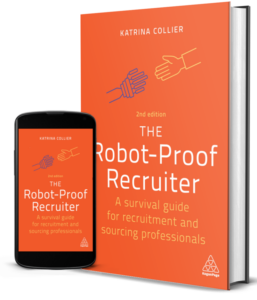We all fall into recruiting.
It’s not exactly a degree from a university or even a job we hear about as kids. Everyone talks about doctors and lawyers, but rarely do they talk about the HR generalist or recruiting agency that helped them find the job in the first place. That lack of an education pipeline and singular success methodology leaves a lot of recruiting up for interpretation. We borrow and build the best plan using the strategies found across a range of industries, from pipeline marketing to agile software engineering.
Our guests, Natalie Glick and Mark Lundgren from ThoughtWorks, were no exception. Neither were children screaming to their parents about interviewing and sourcing strategies; like so many of us, they “fell into” recruiting – and after 17 years each, have lived to tell many tales. Both spent time at an agency, an experience that helped them both with their “pick up the phone and make it happen” attitudes.
“It is very hard to get that, when you’ve been in-house your whole career, you don’t have it ingrained in you to get on the phone and not have the fear.”
But their fearlessness on the phone is just one of their strategies for success.
Natalie and Mark’s company, Thoughtworks, was a pioneer in the agile software development movement about 20 years ago. Agile is built on a series of methodologies that, at their most simplistic, get work done faster with iterative, collaborative development. Mark, after studying the history and methodologies of agile during his own discussions with candidates, quickly realized there was an opportunity to translate engineering’s best practices into what they today call “agile sourcing.”
“Within a few weeks, we had one of our agile coaches with us going through the process he thought would work,” said Lundgren. Breaking down their process into every specific element, they actively worked to identify and remove blockers. Then, organizing those projects into sprints led to more predictable outcomes. “For example: week 1, identifying development candidates; week 2, reaching out to them; week 3, following up; week 4, phone screens if applicable,” explained Glick on our show.
“Well, all I knew was that recruiters weren’t liked!”
Scrums, swarms and agile sourcing
Ultimately, success came with the infusion of collaboration and targeted efforts called swarms. Swarming is where everyone works on one project to solve it in a more targeted way. Glick offered advice for creating your own agile sourcing swarm:
- Everyone identify 25 today – with five sourcers, that’s 100 people.
- Source together and talk through with each other.
- Aim for 50:50 men and women in the first round of identifying to try to ensure diversity.
There are already recruiting pros just like you incorporating agile sourcing into their plans just from listening to them speak!
Thought you would like to know @KatrinaMCollier, @RecruitMark, @nglick, @media2knight – I sat down over the weekend and have rolled out “Paired Sourcing” and an Agile Sprint to my team for our key accounts. Will be interesting to see how it works “agency side” #SocialRecruiting
I can’t wait to see the results.
If that wasn’t enough, below you’ll hear Natalie & Mark share more:-


